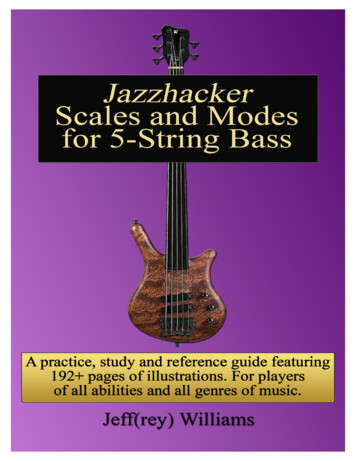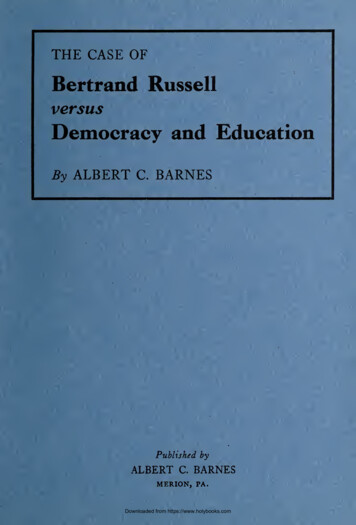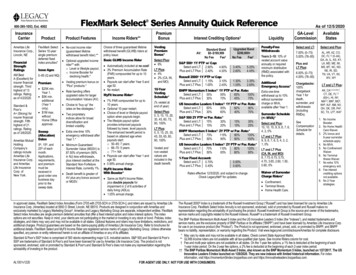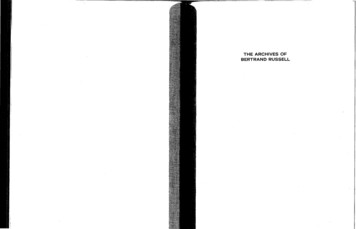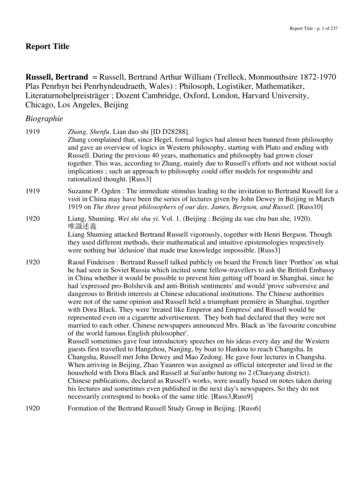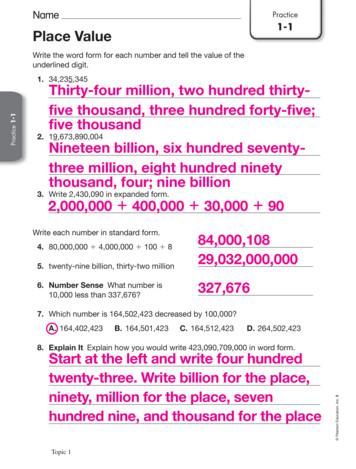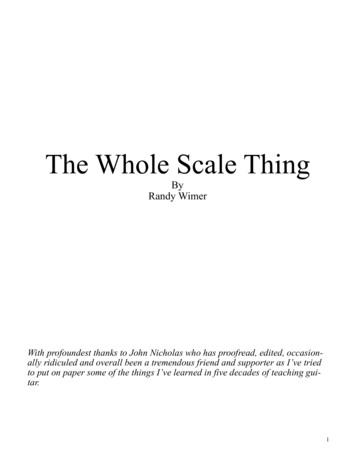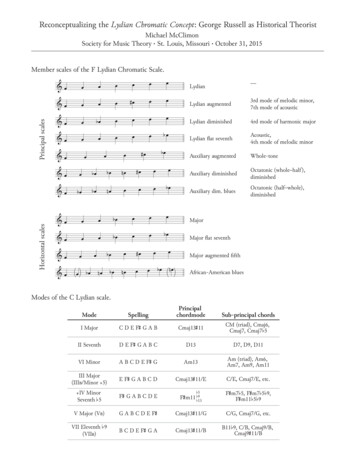
Transcription
Reconceptualizing the Lydian Chromatic Concept: George Russell as Historical TheoristMichael McClimonSociety for Music Theory . St. Louis, Missouri . October 31, 2015Member scales of the F Lydian Chromatic Scale.&œPrincipal scales&œ&œ&œ&œHorizontal scales&œœœ&œbœ&œœ&œ&œ&œ(œ �œ3rd mode of melodic minor,7th mode of acousticLydian diminished4rd mode of harmonic majorLydian flat seventhAcoustic,4th mode of melodic minorAuxiliary augmentedWhole-toneAuxiliary diminishedOctatonic (whole–half ),diminishedAuxiliary dim. bluesOctatonic (half–whole),diminishedMajor flat seventhœbœLydian œœœœœœœœœnœMajor augmented fifth( )African-American bluesModes of the C Lydian scale.ModeSpellingPrincipalchordmodeI MajorC D E Fs G A BCmaj13s11CM (triad), Cmaj6,Cmaj7, Cmaj7f5II SeventhD E Fs G A B CD13D7, D9, D11VI MinorA B C D E Fs GAm13Am (triad), Am6,Am7, Am9, Am11III Major(IIIB/Minor 5)E Fs G A B C DCmaj13s11/EC/E, Cmaj7/E, etc. IV MinorSeventh b5Fs G A B C D EFsm11 f9f13Fsm7f5, Fsm7f5f9,Fsm11f5f9V Major (VB)G A B C D E FsCmaj13s11/GC/G, Cmaj7/G, etc.VII Eleventh b9(VIIB)B C D E Fs G ACmaj13s11/BB11f9, C/B, Cmaj9/B,Cmaj9s11/Bf5Sub-principal chords
Common chords in the modes of the F Lydian Chromatic Scale. (Inspired by Russell’s Chart A.)DiatonicLyd. augmented Lyd. diminishedLyd. f7Whole-toneWH diminished HW GAfBfBCsDEIFmaj7LydianFmaj7s5Lyd. augmented–Harmonic majorF7AcousticFaug (triad)F 7IIG7MixolydianG7s11, G7f5Lydian dominantG7f9G7s5G7s5, G7f5 IVBm7f5LocrianBm7f5Locrian s2B 7Bm7f5Altered, dim.WTVIDm7DorianDmM7Melodic minorDm7f5VIIE7f9PhrygianE7f9E7alt.G7f9, G7f5D f7s5, D f7s9Dm7f9Alternate scale names are given in italics; less common chords are shown in gray.Complete slides/examples available online via the SMT conference website or at www.mcclimon.org/projects/lcc.html.Please feel free to contact me via email (michael@mcclimon.org) or on Twitter (@mmcclimon).FAfABfBCDEfFmaj7, Fm7, F7Bm7f5D f7s5, D f7f5 VFGfAfABCDEfBluesDm7, Dm7f5
Reconceptualizing theLydian Chromatic Concept:George Russell as Historical TheoristMichael McClimonmichael@mcclimon.org
1998 – Caplin, Classical Form 1999 – Krebs, Fantasy Pieces 2001 – Lerdahl, Tonal Pitch Space 2001 – Lydian Chromatic Concept, 4th ed.
Lydian Chromatic Concept Chord/scale equivalence Lydian tonal organization
Lydian Tonal Organization
a)&?wwwwwwwww# wwwwwwwwwb)wwwwwww#wwwwwww
Tonal Gravity&?#wwwwwww
The L YDIAN T ONIC , as the musical “Star-Sun,” is theseminal source of tonal gravity and organization of aLydian Chromatic scale. [ ] U NITY is the state in whichthe Lydian Scale exists in relation to its I major and VIminor tonic station chords, as well as those on other scaledegrees. Unity is . . . instantaneous completeness andoneness in the Absolute Here and Now . . . above lineartime.
The Lydian Scale is the musical passive force. Its unified tonalgravity field, ordained by the ladder of fifths, serves as atheoretical basis for tonal organization within the LydianChromatic Scale and, ultimately, for the entire Lydian ChromaticConcept. There is no “goal pressure” within the tonal gravity fieldof a Lydian Scale. The Lydian Scale exists as a self-organized Unityin relations to its tonic tone and tonic major chord. The LydianScale implies an evolution to higher levels of tonal organization.The Lydian Scale is the true scale of tonal unity and the scalewhich clearly represents the phenomenon of tonal gravity itself.Lydian Chromatic Concept, pp. 8–9
Only genius is imbued with a sense of tonal space. It is itsinnate awareness, just as the concepts of physical space(as extension of of the human body) and time (as growthand development of the body) are inborn, innate in everyhuman as part of the sense of their own body.Schenker, “Elucidations,” Tonwille 8/9 (1924)On rare occasions one encounters the substitution of aninversion for the V or V7 chord at the MC point. Regardlessof whether the dominant has previously appeared in rootposition, this situation should be understood as a medialcaesura deformation, which might well impact thesubsequent S.Hepokoski/Darcy, Elements of Sonata Theory, p. 26 (2008)
Lydian Chromatic Order ofTonal Gravitym9F C G D A E B C A E B G NB: not a P5
Lydian Chromatic Order ofTonal GravityF C G D A E B F C A E B all Lydian tonics?P5
“Interval Tonic Justification”C Lydian Scale & œ̇œ̇œ̇œ̇Octave Maj 7th Min 7th Maj 6th Aug 5th & C major scaleœ̇œ̇œ̇œ̇œ̇# œ̇œ̇FifthAug 4th Fourthœ̇œ̇( ) œ̇œ̇œ̇ œœ Maj 3rd Min 3rd Maj 2nd Min 2ndœ̇œ̇ œœ
Lydian Chromatic Order ofTonal GravityI V II VI III VII IV V III VII IV II
Member scale criteriaa) a scale’s capacity to parent chords consideredimportant in the development of Western harmonyb) a scale as being most representative of a tonal level ofthe Lydian Chromatic scalec) the historical and/or sociological significance of ascale(Lydian Chromatic Concept, p. 12)
Russell’s names&œ&œ&œ&œ&œœœœLydianœœ#œœœLyd. augmented3rd mode ofmelodic minorbœœœœœLyd. diminished4th mode ofharmonic majorœœœœbœLyd. flat seventhLyd. dominant,acoustic edoctatonic (whole-half ),diminishedAuxiliarydiminished bluesoctatonic bœ#œœœœœOther common namesbœnœ#œœœnœœœœbœ
12 TONE ORDERAux.Dim.BluesOUTGOING TONAL GRAVITY LEVEL11 TONE ORDERAux.Dim.SEMI-OUTGOING TONAL GRAVITY LEVEL10 TONE ORDERSEMI-OUTGOING TONAL GRAVITY LEVEL9 TONE ORDERLydianb7CONSONANT NUCLEUSSEMI-INGOING TONAL GRAVITY LEVELLydianDim.LydianAug.7 TONE ORDERINGOING TONAL GRAVITY LEVELLydianLYDIANTONICAux.Aug.IVIIVIIIIVII IV )(Ef)(Bf)(Gf)
MajorMajorflat seventhMajoraugmented fifthAfrican-Americanblues&œ&œ& œœœœœœœbœbœœœœbœœœbœœ& œ (œ ) b œ n œ b œ n œœ#œœœœb œ ( n œ)
Chord/Scale Equivalence
In a conversation I had with Miles Davis in 1945, I asked,“Miles, what’s your musical aim?” His answer, “to learnall the changes (chords),” was somewhat puzzling tome since I felt—and I was hardly alone in the feeling—that Miles played like he already knew all the chords.After dwelling on his statement for some months, Ibecame mindful that Miles’s answer may have impliedthe need to relate to chords in a new way.
This motivated my quest to expand the tonalenvironment of the chord beyond the immediate tonesof its basic structure, leading to the irrevocableconclusion that every traditionally definable chord ofWestern music theory has its origin in a PARENT SCALE . Inthis vertical sense, the term refers to that scale which isordained—by the nature of tonal gravity—to be a chord'ssource of arising, and ultimate vertical completeness; thechord and its parent scale existing in a state of completeand indestructible chord/scale unity—a CHORDMODE .(Lydian Chromatic Concept, p. 10)
The chord and its parent scale are an inseparableentity—the reciprocal sound of one another. . . . Inother words, the complete sound of a chord is itscorresponding mode within its parent scale. Therefore,the broader term CHORDMODE is substituted for what isgenerally referred to as “the chord.”(Lydian Chromatic Concept, p. 20–21)
ModeSpellingPrincipalchordmodeI MajorC D E Fs G A BCmaj13s11CM (triad), Cmaj6,Cmaj7, Cmaj7f5II SeventhD E Fs G A B CD13D7, D9, D11Sub-principal chordsVI MinorA B C D E Fs GAm13Am (triad), Am6,Am7, Am9, Am11III Major(IIIB/Minor 5)E Fs G A B C DCmaj13s11/EC/E, Cmaj7/E, etc. IV MinorSeventh b5Fs G A B C D Ef5Fsm11 f9f13Fsm7f5, Fsm7f5f9,Fsm11f5f9V Major (VB)G A B C D E FsCmaj13s11/GC/G, Cmaj7/G, etc.Cmaj13s11/BB11f9, C/B, Cmaj9/B,Cmaj9s11/BVII Eleventh b9(VIIB)B C D E Fs G A
Primary Modal GenreA PMG is an assemblage of Principal Chord Families ofsimilar type: a Principal Chord Family mansion housingthe spectrum of variously colored Principal ChordFamilies of the same essential harmonic genre.(Lydian Chromatic Concept, p. 29)
Mode 2, C auxiliary diminishedAs a scale&?œbœAs a chordœ#œbœnœœœs9D13 f9f5b wwwwwb # wwww
Primary Modal Tonic Primary Modal GenreImajor and altered major chordsIIseventh and altered seventh chordsIII[I] major and altered [I] major 3B (minor 5) chords IVminor seventh 5 / [I] major 4B chordsV[I] major and altered [I]5B chordsVIminor and altered minor chordsVIIeleventh 9 / [I] major 7B chords Vseventh 5 chords
Finding a Parent Scale
E 7D M2
Finding a Parent ScaleSo, if the chord isE 7then the Lydian Tonic isD and the Parent scale isD Lydian
Finding a Parent ScaleE 7 – 2nd mode of D LydianE 7 – E Mixolydian
Finding a Parent ScaleE 77R9& b b œ7R9& b b 7n7& b nœf9nœ b 311b f13119œ53 bœ5bœ œœbœ13311bœb 5bœf13D LydianD Lydian 7D aux. dim.blues
Chord/Scale Theory after Russell
Jamey Aebersold – Jazz Handbook. Richard Grag/Barrie Nettles – The Chord Scale Theoryand Jazz Harmony Andy Jaffe – Jazz Harmony Mark Levine – The Jazz Theory Book Joe Mulholland/Tom Hojnacki – The Berklee Book ofJazz Harmony
Levine’s chapter onchord-scale theory Major scale harmony Melodic minor scale harmony Diminished scale harmony Whole-tone scale harmony
Major-scale harmony (from Levine)IonianCmaj7 (avoid sd 4)DorianDm7PhrygianEsus 9LydianFmaj7 4MixolydianG7 (avoid sd 4); GsusAeolianAm 6LocrianBm7 5
Minor-scale harmony (from Levine)ICmM7minor-majorIIDsus 9—IIIE maj7 5Lydian augmentedIVF7 11Lydian dominantVCmM7/G—VIAm7 5half-diminished; Locrian 2VIIB7alt.altered; dim. whole-tone
The notion of chord/scale unity as the logical approach tothe vertical manifestation of harmony was simplyoverlooked by classical Western theorists. Theunderstanding that the term HARMONY means UNITY, andalready complete VERTICAL ONENESS of elementsexisting in the momentary NOW above time was eithermissed or dismissed by the founding fathers of Westernclassical music theory.Lydian Chromatic Concept, p. 222
Aebersold, Jamey. Jazz Handbook. New Albany, IN: Jamey Aebersold Jazz, ndbook.pdf.Bishop, John. “A Permutational Triadic Approach to Jazz Harmony and the Chord/Scale Relationship.” PhD diss., Louisiana State University, 2012.Clement, Brett. “A New Lydian Theory for Frank Zappa’s Modal Music.” Music TheorySpectrum 36, no. 1 (Spring 2014): 146–66.Graf, Richard, and Barrie Nettles. The Chord Scale Theory and Jazz Harmony. AdvanceMusic, 1997.Jaffe, Andy. Jazz Harmony. Tübingen: Advance Music, 1996.Jones, Olive. “A New Theory for Jazz.” The Black Perspective in Music 2, no. 1 (Spring1974): 63–74.Levine, Mark. The Jazz Theory Book. Petaluma, CA: Sher Music, 1995.Mulholland, Joe, and Tom Hojnacki. The Berklee Book of Jazz Harmony. Boston:Berklee Press, 2013.Russell, George. The Lydian Chromatic Concept of Tonal Organization. 4th ed. The Art andScience of Tonal Gravity. Brookline, MA: Concept, 2001.Tymoczko, Dmitri. “The Consecutive-Semitone Constraint on Scalar Structure: a LinkBetween Impressionism and Jazz.” Intégral 11 (1997): 135–79.———. A Geometry of Music: Harmony and Counterpoint in the Extended CommonPractice. New York: Oxford University Press, 2011.
Western music theory has its origin in a PARENT SCALE. In this vertical sense, the term refers to that scale which is ordained—by the nature of tonal gravity—to be a chord's source of arising, and ultimate vertical completeness; the chord and its parent scale existing in a state of complete and indestructible chord/scale unity—a CHORDMODE.

